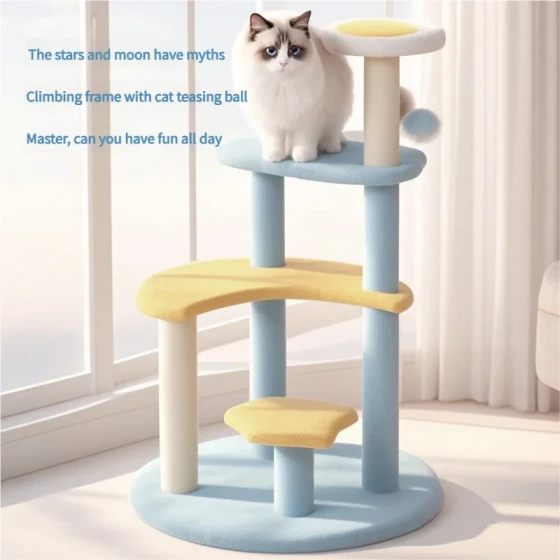What to Prepare for Cat Delivery_List of Delivery Supplies
To be honest, assisting a cat with delivery sounds both nerve-wracking and a bit mysterious since it’s welcoming new life. But don’t be intimidated by movie plots; most of the time, the mother cat is the best "midwife" herself. As "pet parents and human support team," the most important thing isn’t to "deliver" but to be well-prepared, provide a safe and comfortable environment, offer just the right support at critical moments, or more importantly—know when to hand the baton to professional veterinarians.
Core summary in one sentence: Preparing for a cat’s delivery is like creating a dedicated “maternity center” and emergency kit for an expectant mother—being fully equipped, staying calm, and decisively seeking professional help when necessary is the way to go.

Creating Her "Five-Star Maternity Center": Delivery Room Setup
Cats exhibit an instinctive "nesting" behavior before delivery, searching for a secluded, safe, and warm place—maybe deep inside your wardrobe or a "secret base" under the bed. Instead of searching the whole house later, prepare a dedicated "delivery room" beforehand. This is like a custom-made "five-star maternity center" for her to feel secure and relaxed.
Location:
Choose the quietest spot in the house with the least foot traffic. Avoid living rooms, hallways, and other busy areas, and keep distance from other pets. This could be a seldom-used corner of a room, a storage nook, or even a quiet closet. The key is quiet, hidden, warm, dry, and safe.
"Building" materials:
A large enough cardboard box, plastic storage box, or a dedicated pet delivery crate is essential. The size should allow the mother cat to comfortably stretch and also provide enough space for the kittens once born. A common standard is at least 1.5 to 2 times the mother’s body length. One side of the box should have a low opening for easy in-and-out access and to prevent newborn kittens, who have little mobility, from rolling out. Some pet owners opt for a higher opening and cut a hole on the side big enough for the mother cat to enter, which also increases seclusion.
Interior decoration:
Use soft, absorbent, easy-to-change and clean materials for bedding. Lay down a layer of old newspapers or pet pee pads to facilitate cleaning. Over this, put soft old towels, blankets, or pet mats. Prepare multiple sets for frequent changes to keep the delivery room clean and dry. Remember, newborn kittens are very sensitive to cold, so a warm environment is crucial. The ideal delivery room temperature is usually between 24-27°C, and some sources suggest even higher—around 30°C—for the kitten area. You can use pet-specific electric heating pads (set to low temperature to prevent burns) or far-infrared lamps (maintain a safe distance to avoid overheating and do not shine directly into the cat’s eyes) to provide extra warmth, but safety precautions must be taken to avoid burns for the mother and kittens.
Details decide success:
Set up the delivery room 1-2 weeks or even earlier so the mother cat has enough time to familiarize herself and accept the new space. You can place her favorite toys or scented items inside to encourage her to rest there. You can also try placing her food bowl, water bowl, and litter box nearby (but not too close, especially the litter box), so she knows this area is her own. Many mother cats eventually choose the spot where they feel the safest to give birth—even if you prepare the perfect delivery room, she might "change her mind at the last minute" and go elsewhere. This is normal; don’t force her. Respect her choice and quickly prepare the place she selects.
Complete Her "Logistics Support and Emergency Kit": Delivery Supplies List
Though we are mainly observers, having some essentials ready prevents panicking if intervention or emergencies arise. It’s like equipping her "maternity center" with a fully functional "logistics department" and a small "emergency response team."
An itemized checklist helps you stay prepared:
- Cleaning and hygiene supplies:
- Clean, soft towels/cloths: Plenty! For cleaning messes and wiping newborn kittens. Prepare extras to change as needed.
- Pet pee pads or old newspapers: Placed under bedding to absorb moisture and facilitate replacement.
- Disinfection supplies: Pet-safe disinfectant solutions (e.g., diluted iodine), medical alcohol swabs/pads. For hand and tool disinfection.
- Disposable gloves: Use when handling mother or kittens to maintain hygiene and reduce bacteria spread.
- Warm water: A basin of warm water for cleaning.
- Possible auxiliary tools:
- Disinfected scissors: In case the mother does not bite off the umbilical cord herself (very rare), you might need to cut it manually. Be sure to sterilize with alcohol or iodine beforehand and ensure they are sharp.
- Thick cotton thread or unwaxed dental floss: For tying off the umbilical cord. Also sterilized. Tie about 2-3 cm from the kitten’s abdomen.
- Warming supplies:
- Pet-specific electric heating pad (with temperature control) or hot water bottle: Wrapped in a towel and placed in a corner or under the delivery box to provide extra heat. Monitor temperature carefully to avoid burns.
- Extra blankets/towels: To wrap newborn kittens and keep them warm.
- Nutrition and feeding (backup):
- Mother cat’s favorite food and water: Placed near the delivery room for easy access to energy and hydration.
- Kitten formula and feeding bottle/syringe: In case of insufficient mother’s milk or if the mother cat refuses to nurse. Make sure the formula is kitten-specific, as cow’s milk is unsuitable for kittens.
- Monitoring and recording:
- Small scale (optional): To monitor newborn kittens’ weight gain and assess adequate nutrition.
- Notebook and pen: Record each kitten’s birth time, sex (if identifiable), weight, condition, and placenta delivery. This information is important for the vet.
- Emergency preparedness:
- Know and keep the vet’s contact info: Including regular hours and emergency/nightline! This cannot be overstated.
- Prepare a pet carrier: For quick safe transport of mother and kittens to the hospital if needed urgently.
- Flashlight: To aid observation, especially in dimly lit delivery rooms.
Labor "Signal Lights" and When to Call for "Reinforcements"
Understanding the signs before labor helps us better judge timing and stay calm. It’s like watching the sky, knowing rain is likely when clouds gather.
Signs before labor:
As the due date approaches (normally cats are pregnant for 63-65 days), observe changes in the mother’s behavior.
* Increased nesting behavior: She’ll often check and stay in the prepared delivery room or may seek a new "secret base."
* Behavior changes: She might become more clingy than usual or, conversely, more anxious, hiding, or even aggressive.
* Decreased or refused appetite: Appetite often decreases noticeably or stops as delivery nears.
* Body temperature drop: Within 24 hours before delivery, her rectal temperature may drop about 1℃ (usually between 38℃-38.8℃, dropping to around 37.8℃).
* Licking the vulva: Frequent licking of the vulva, possibly with a small amount of mucus or faint blood streaks.
* Mammary changes: Breasts and nipples become visibly swollen, reddened, sometimes producing milk.
Signs during labor:
When real labor starts, clearer signs appear:
* Contractions: Noticeable abdominal contractions, initially mild, gradually intensifying and becoming frequent.
* Rapid breathing, purring, or soft moaning: Normal physiological responses, don’t overly worry.
* Water breaks: You might see fluid discharge, usually clear or slightly colored.
* Presence of membranes: Gray or semi-transparent membranes wrapping a kitten may appear at the vulva.
When to immediately contact a vet?
Though most cats deliver naturally and smoothly, knowing abnormalities and seeking help promptly is crucial. These are the “emergency response team” signals.
* Strong contractions lasting more than 1 hour without kitten delivery.
* Water breaking more than 1-2 hours with no kittens born.
* A kitten stuck in the vulva with part of the body exposed for over 10-15 minutes, mother pushing continuously but unable to deliver.
* More than 2 hours between two kittens’ births (normal is usually 10-60 minutes, though this varies. If the interval is long and the mother is lethargic and stops pushing, be alert).
* Mother cat showing extreme pain, continuous crying, lethargy, trembling, or weakness.
* Vaginal bleeding with large amounts of bright red blood, foul-smelling discharge, or persistent green discharge (green discharge accompanied by placenta delivery can be normal, but green discharge without kittens is a danger sign).
* Mother’s body temperature abnormally high (may suggest infection).
* Known remaining fetuses in the womb but the mother has stopped all efforts and appears exhausted.
If you encounter these conditions, do not hesitate to contact the vet immediately, describe the situation in detail, follow professional guidance, or prepare to go to the hospital. The vet may recommend drugs to assist delivery or a cesarean section.
Welcoming New Life and Initial Postpartum Care
When the kittens are born smoothly, the mother usually licks the membranes open, bites off the umbilical cords, and cleans the kittens herself. Our main task is to ensure a quiet, warm environment and observe nearby.
- Observe kittens: Make sure all kittens breathe smoothly and quickly find a nipple to start nursing. Colostrum is critical for newborns’ immunity.
- Count placentas: Try to record the number of delivered placentas, which theoretically should match the number of kittens. Retained placenta in the mother may cause infection.
- Keep delivery room clean: During breaks or after delivery, carefully replace soiled bedding to maintain dry and sanitary conditions.
- Provide ample nutrition: Delivery and nursing consume significant energy; ensure the mother has constant access to nutritious, easily digestible food and plenty of water.
Final Words
Preparing for a cat's delivery is a meticulous yet hopeful task. We are like backstage workers for this celebration of life—building the stage, setting props, ensuring smooth progress, and stepping up to assist or bring in a professional “director” (veterinarian) when challenges arise. Staying calm, preparing thoroughly, observing closely, and seeking help timely make the entire process safer and more reassuring. After all, welcoming a litter of fluffy new lives is an incredibly wonderful thing.
Wishing your mother cat a smooth delivery and your kittens healthy growth!



-560x560.webp)